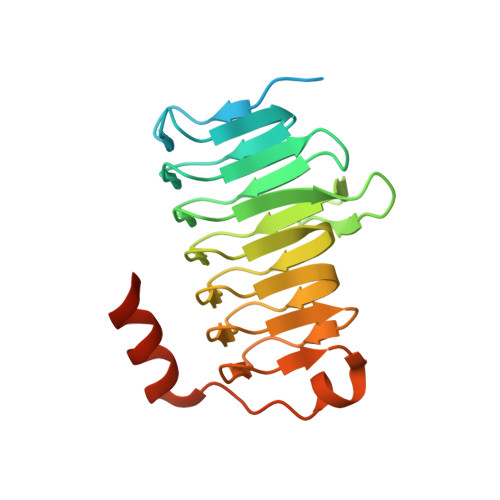Structural basis of the oxidative activation of the carboxysomal {gamma}-carbonic anhydrase, CcmM.
Pena, K.L., Castel, S.E., de Araujo, C., Espie, G.S., Kimber, M.S.(2010) Proc Natl Acad Sci U S A 107: 2455-2460
- PubMed: 20133749
- DOI: https://doi.org/10.1073/pnas.0910866107
- Primary Citation of Related Structures:
3KWC, 3KWD, 3KWE - PubMed Abstract:
Cyanobacterial RuBisCO is sequestered in large, icosahedral, protein-bounded microcompartments called carboxysomes. Bicarbonate is pumped into the cytosol, diffuses into the carboxysome through small pores in its shell, and is then converted to CO(2) by carbonic anhydrase (CA) prior to fixation. Paradoxically, many beta-cyanobacteria, including Thermosynechococcus elongatus BP-1, lack the conventional carboxysomal beta-CA, ccaA. The N-terminal domain of the carboxysomal protein CcmM is homologous to gamma-CA from Methanosarcina thermophila (Cam) but recombinant CcmM derived from ccaA-containing cyanobacteria show no CA activity. We demonstrate here that either full length CcmM from T. elongatus, or a construct truncated after 209 residues (CcmM209), is active as a CA-the first catalytically active bacterial gamma-CA reported. The 2.0 A structure of CcmM209 reveals a trimeric, left-handed beta-helix structure that closely resembles Cam, except that residues 198-207 form a third alpha-helix stabilized by an essential Cys194-Cys200 disulfide bond. Deleting residues 194-209 (CcmM193) results in an inactive protein whose 1.1 A structure shows disordering of the N- and C-termini, and reorganization of the trimeric interface and active site. Under reducing conditions, CcmM209 is similarly partially disordered and inactive as a CA. CcmM protein in fresh E. coli cell extracts is inactive, implying that the cellular reducing machinery can reduce and inactivate CcmM, while diamide, a thiol oxidizing agent, activates the enzyme. Thus, like membrane-bound eukaryotic cellular compartments, the beta-carboxysome appears to be able to maintain an oxidizing interior by precluding the entry of thioredoxin and other endogenous reducing agents.
- Department of Molecular and Cellular Biology, University of Guelph, Guelph, ON, Canada.
Organizational Affiliation:




















